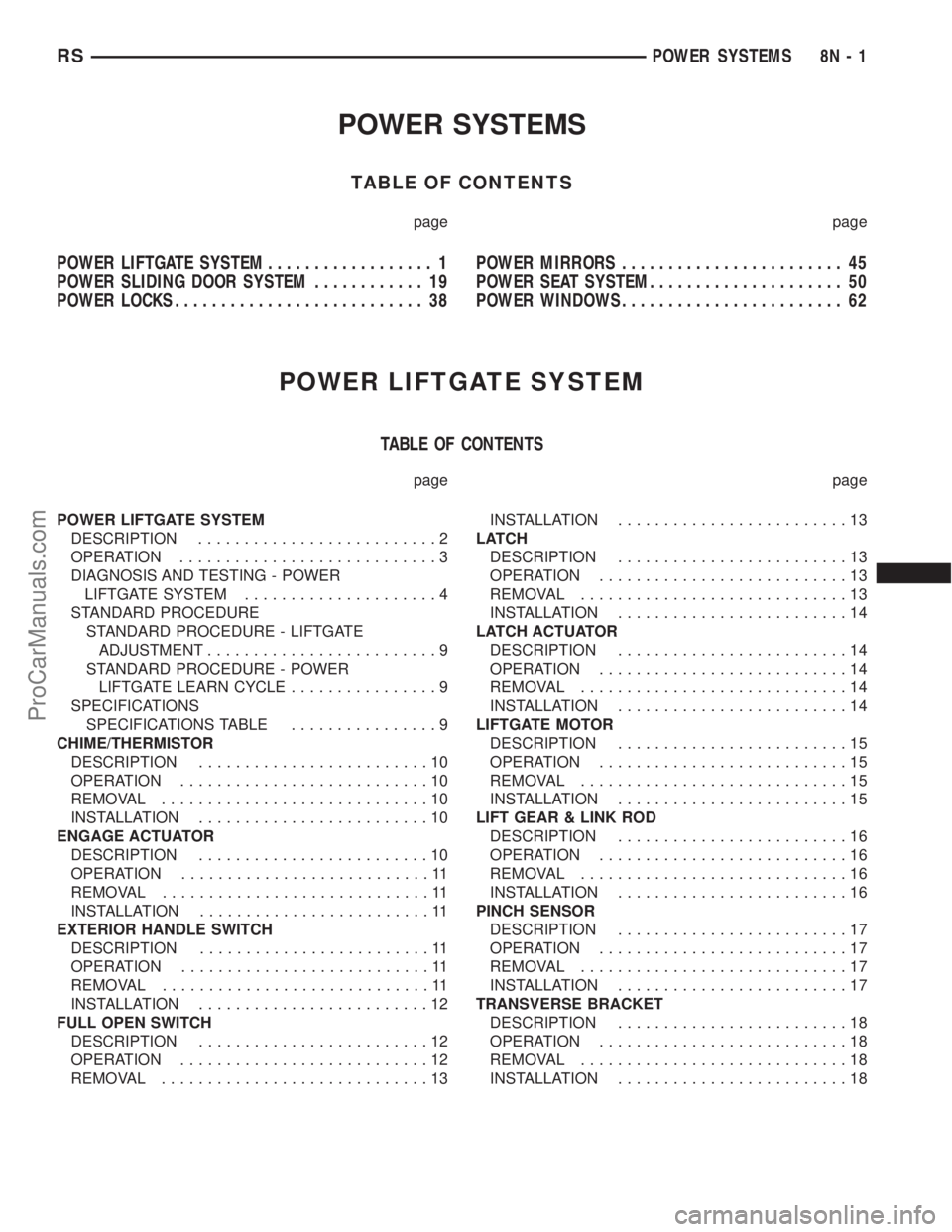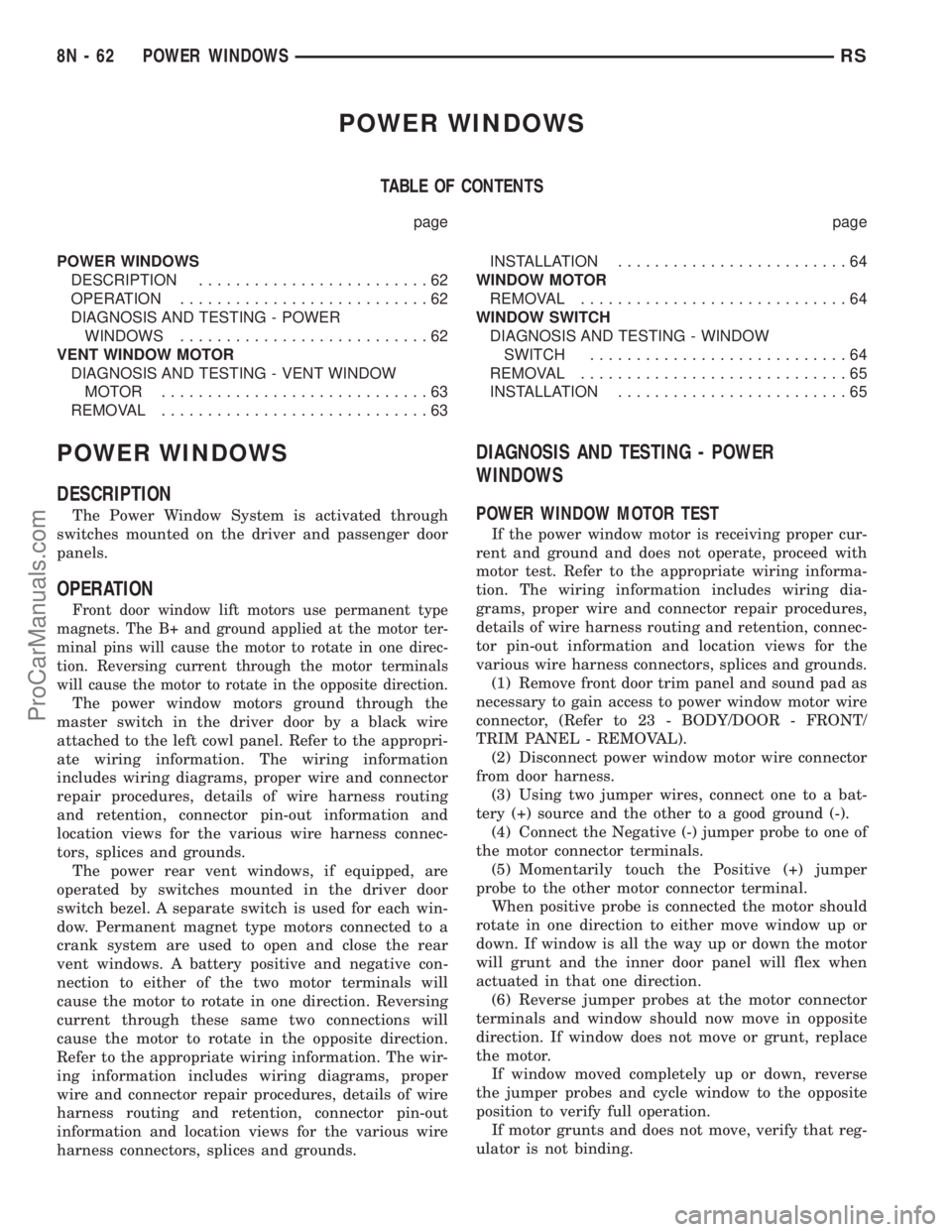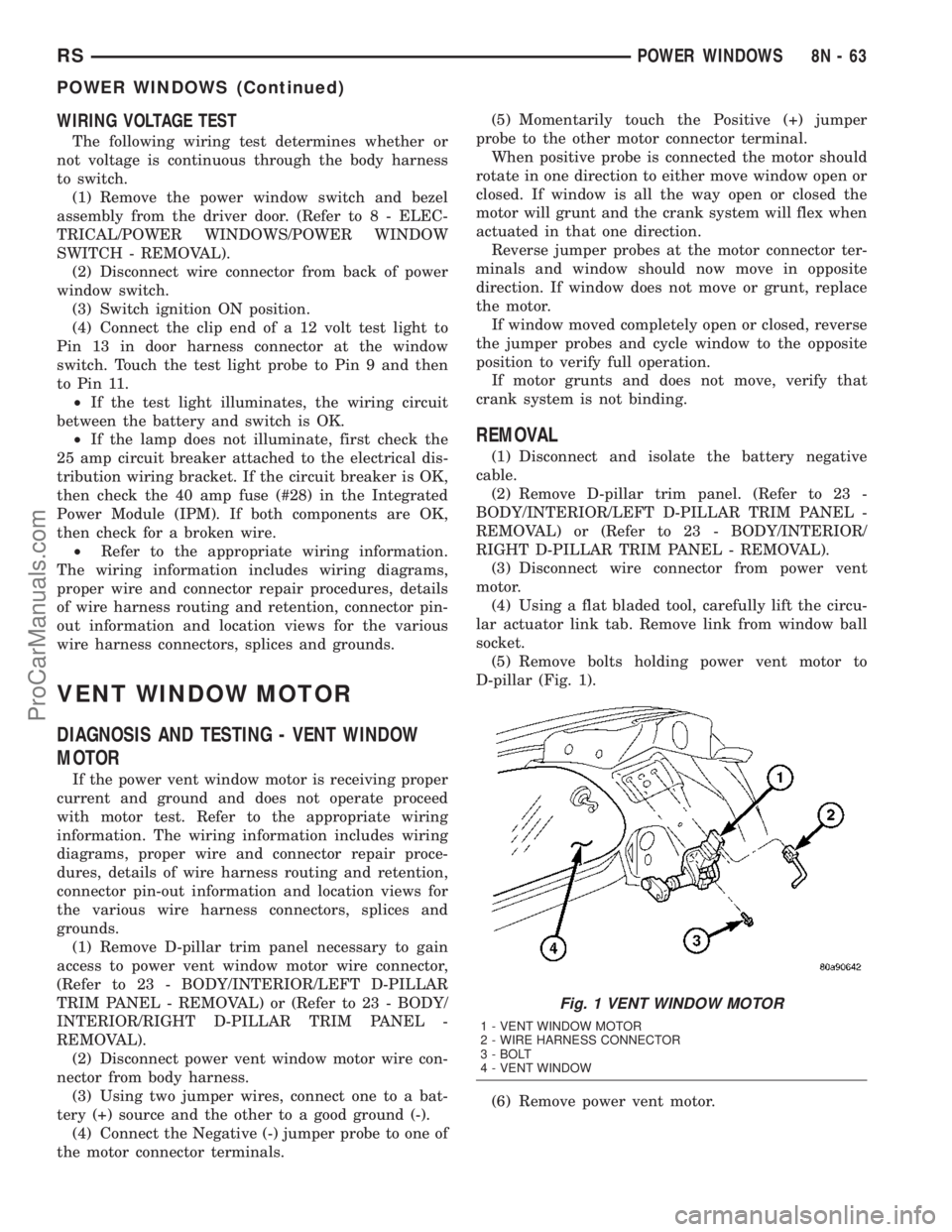Windows CHRYSLER VOYAGER 2003 Service Manual
[x] Cancel search | Manufacturer: CHRYSLER, Model Year: 2003, Model line: VOYAGER, Model: CHRYSLER VOYAGER 2003Pages: 2177, PDF Size: 59.81 MB
Page 456 of 2177

POWER SYSTEMS
TABLE OF CONTENTS
page page
POWER LIFTGATE SYSTEM.................. 1
POWER SLIDING DOOR SYSTEM............ 19
POWER LOCKS........................... 38POWER MIRRORS........................ 45
POWER SEAT SYSTEM..................... 50
POWER WINDOWS........................ 62
POWER LIFTGATE SYSTEM
TABLE OF CONTENTS
page page
POWER LIFTGATE SYSTEM
DESCRIPTION..........................2
OPERATION............................3
DIAGNOSIS AND TESTING - POWER
LIFTGATE SYSTEM.....................4
STANDARD PROCEDURE
STANDARD PROCEDURE - LIFTGATE
ADJUSTMENT.........................9
STANDARD PROCEDURE - POWER
LIFTGATE LEARN CYCLE................9
SPECIFICATIONS
SPECIFICATIONS TABLE................9
CHIME/THERMISTOR
DESCRIPTION.........................10
OPERATION...........................10
REMOVAL.............................10
INSTALLATION.........................10
ENGAGE ACTUATOR
DESCRIPTION.........................10
OPERATION...........................11
REMOVAL.............................11
INSTALLATION.........................11
EXTERIOR HANDLE SWITCH
DESCRIPTION.........................11
OPERATION...........................11
REMOVAL.............................11
INSTALLATION.........................12
FULL OPEN SWITCH
DESCRIPTION.........................12
OPERATION...........................12
REMOVAL.............................13INSTALLATION.........................13
LATCH
DESCRIPTION.........................13
OPERATION...........................13
REMOVAL.............................13
INSTALLATION.........................14
LATCH ACTUATOR
DESCRIPTION.........................14
OPERATION...........................14
REMOVAL.............................14
INSTALLATION.........................14
LIFTGATE MOTOR
DESCRIPTION.........................15
OPERATION...........................15
REMOVAL.............................15
INSTALLATION.........................15
LIFT GEAR & LINK ROD
DESCRIPTION.........................16
OPERATION...........................16
REMOVAL.............................16
INSTALLATION.........................16
PINCH SENSOR
DESCRIPTION.........................17
OPERATION...........................17
REMOVAL.............................17
INSTALLATION.........................17
TRANSVERSE BRACKET
DESCRIPTION.........................18
OPERATION...........................18
REMOVAL.............................18
INSTALLATION.........................18
RSPOWER SYSTEMS8N-1
ProCarManuals.com
Page 517 of 2177

POWER WINDOWS
TABLE OF CONTENTS
page page
POWER WINDOWS
DESCRIPTION.........................62
OPERATION...........................62
DIAGNOSIS AND TESTING - POWER
WINDOWS...........................62
VENT WINDOW MOTOR
DIAGNOSIS AND TESTING - VENT WINDOW
MOTOR .............................63
REMOVAL.............................63INSTALLATION.........................64
WINDOW MOTOR
REMOVAL.............................64
WINDOW SWITCH
DIAGNOSIS AND TESTING - WINDOW
SWITCH............................64
REMOVAL.............................65
INSTALLATION.........................65
POWER WINDOWS
DESCRIPTION
The Power Window System is activated through
switches mounted on the driver and passenger door
panels.
OPERATION
Front door window lift motors use permanent type
magnets. The B+ and ground applied at the motor ter-
minal pins will cause the motor to rotate in one direc-
tion. Reversing current through the motor terminals
will cause the motor to rotate in the opposite direction.
The power window motors ground through the
master switch in the driver door by a black wire
attached to the left cowl panel. Refer to the appropri-
ate wiring information. The wiring information
includes wiring diagrams, proper wire and connector
repair procedures, details of wire harness routing
and retention, connector pin-out information and
location views for the various wire harness connec-
tors, splices and grounds.
The power rear vent windows, if equipped, are
operated by switches mounted in the driver door
switch bezel. A separate switch is used for each win-
dow. Permanent magnet type motors connected to a
crank system are used to open and close the rear
vent windows. A battery positive and negative con-
nection to either of the two motor terminals will
cause the motor to rotate in one direction. Reversing
current through these same two connections will
cause the motor to rotate in the opposite direction.
Refer to the appropriate wiring information. The wir-
ing information includes wiring diagrams, proper
wire and connector repair procedures, details of wire
harness routing and retention, connector pin-out
information and location views for the various wire
harness connectors, splices and grounds.
DIAGNOSIS AND TESTING - POWER
WINDOWS
POWER WINDOW MOTOR TEST
If the power window motor is receiving proper cur-
rent and ground and does not operate, proceed with
motor test. Refer to the appropriate wiring informa-
tion. The wiring information includes wiring dia-
grams, proper wire and connector repair procedures,
details of wire harness routing and retention, connec-
tor pin-out information and location views for the
various wire harness connectors, splices and grounds.
(1) Remove front door trim panel and sound pad as
necessary to gain access to power window motor wire
connector, (Refer to 23 - BODY/DOOR - FRONT/
TRIM PANEL - REMOVAL).
(2) Disconnect power window motor wire connector
from door harness.
(3) Using two jumper wires, connect one to a bat-
tery (+) source and the other to a good ground (-).
(4) Connect the Negative (-) jumper probe to one of
the motor connector terminals.
(5) Momentarily touch the Positive (+) jumper
probe to the other motor connector terminal.
When positive probe is connected the motor should
rotate in one direction to either move window up or
down. If window is all the way up or down the motor
will grunt and the inner door panel will flex when
actuated in that one direction.
(6) Reverse jumper probes at the motor connector
terminals and window should now move in opposite
direction. If window does not move or grunt, replace
the motor.
If window moved completely up or down, reverse
the jumper probes and cycle window to the opposite
position to verify full operation.
If motor grunts and does not move, verify that reg-
ulator is not binding.
8N - 62 POWER WINDOWSRS
ProCarManuals.com
Page 518 of 2177

WIRING VOLTAGE TEST
The following wiring test determines whether or
not voltage is continuous through the body harness
to switch.
(1) Remove the power window switch and bezel
assembly from the driver door. (Refer to 8 - ELEC-
TRICAL/POWER WINDOWS/POWER WINDOW
SWITCH - REMOVAL).
(2) Disconnect wire connector from back of power
window switch.
(3) Switch ignition ON position.
(4) Connect the clip end of a 12 volt test light to
Pin 13 in door harness connector at the window
switch. Touch the test light probe to Pin 9 and then
to Pin 11.
²If the test light illuminates, the wiring circuit
between the battery and switch is OK.
²If the lamp does not illuminate, first check the
25 amp circuit breaker attached to the electrical dis-
tribution wiring bracket. If the circuit breaker is OK,
then check the 40 amp fuse (#28) in the Integrated
Power Module (IPM). If both components are OK,
then check for a broken wire.
²Refer to the appropriate wiring information.
The wiring information includes wiring diagrams,
proper wire and connector repair procedures, details
of wire harness routing and retention, connector pin-
out information and location views for the various
wire harness connectors, splices and grounds.
VENT WINDOW MOTOR
DIAGNOSIS AND TESTING - VENT WINDOW
MOTOR
If the power vent window motor is receiving proper
current and ground and does not operate proceed
with motor test. Refer to the appropriate wiring
information. The wiring information includes wiring
diagrams, proper wire and connector repair proce-
dures, details of wire harness routing and retention,
connector pin-out information and location views for
the various wire harness connectors, splices and
grounds.
(1) Remove D-pillar trim panel necessary to gain
access to power vent window motor wire connector,
(Refer to 23 - BODY/INTERIOR/LEFT D-PILLAR
TRIM PANEL - REMOVAL) or (Refer to 23 - BODY/
INTERIOR/RIGHT D-PILLAR TRIM PANEL -
REMOVAL).
(2) Disconnect power vent window motor wire con-
nector from body harness.
(3) Using two jumper wires, connect one to a bat-
tery (+) source and the other to a good ground (-).
(4) Connect the Negative (-) jumper probe to one of
the motor connector terminals.(5) Momentarily touch the Positive (+) jumper
probe to the other motor connector terminal.
When positive probe is connected the motor should
rotate in one direction to either move window open or
closed. If window is all the way open or closed the
motor will grunt and the crank system will flex when
actuated in that one direction.
Reverse jumper probes at the motor connector ter-
minals and window should now move in opposite
direction. If window does not move or grunt, replace
the motor.
If window moved completely open or closed, reverse
the jumper probes and cycle window to the opposite
position to verify full operation.
If motor grunts and does not move, verify that
crank system is not binding.
REMOVAL
(1) Disconnect and isolate the battery negative
cable.
(2) Remove D-pillar trim panel. (Refer to 23 -
BODY/INTERIOR/LEFT D-PILLAR TRIM PANEL -
REMOVAL) or (Refer to 23 - BODY/INTERIOR/
RIGHT D-PILLAR TRIM PANEL - REMOVAL).
(3) Disconnect wire connector from power vent
motor.
(4) Using a flat bladed tool, carefully lift the circu-
lar actuator link tab. Remove link from window ball
socket.
(5) Remove bolts holding power vent motor to
D-pillar (Fig. 1).
(6) Remove power vent motor.
Fig. 1 VENT WINDOW MOTOR
1 - VENT WINDOW MOTOR
2 - WIRE HARNESS CONNECTOR
3 - BOLT
4 - VENT WINDOW
RSPOWER WINDOWS8N-63
POWER WINDOWS (Continued)
ProCarManuals.com
Page 519 of 2177

INSTALLATION
(1) Obtain new vent window motor.
(2) Snap the actuator link socket onto the quarter
window ball socket. Using a soft rubber mallet, push
the circular link tab flush with link surface.
(3) Install bolts holding power vent motor to D-pil-
lar.
(4) Reconnect wire connector to power vent motor.
(5) Reconnect the battery negative cable.
(6) Cycle quarter window open/close to verify func-
tion.
(7) Install D-pillar trim panel.
WINDOW MOTOR
REMOVAL
The window motor is incorporated into the window
regulator assembly. If the window motor requires
replacement, the window regulator must be replaced.
(Refer to 23 - BODY/DOOR - FRONT/WINDOW
REGULATOR - REMOVAL).
WINDOW SWITCH
DIAGNOSIS AND TESTING - WINDOW SWITCH
(1) Remove the desired switch to be tested from
the door trim panel. Driver's side (master) or passen-
ger side. (Refer to 8 - ELECTRICAL/POWER WIN-
DOWS/POWER WINDOW SWITCH - REMOVAL).
(2) Using an ohmmeter, Test driver door switch for
continuity as described in (Fig. 2).
POWER WINDOW MASTER SWITCH TEST
SWITCH POSITION CONTINUITY BETWEEN
OFF 13 and 1
13 and 2
13 and 3
13 and 4
13 and 5
13 and 6
13 and 7
13 and 8
SWITCH POSITION CONTINUITY BETWEEN
UP DRIVER 11 and 8
*DOWN DRIVER 11 and 6
*X DOWN DRIVER 11and 6
UP PASSENGER 9 and 4
DOWN PASSENGER 9 and 2
LEFT VENT OPEN 11 and 7
LEFT VENT CLOSE 9 and 3
RIGHT VENT OPEN 9 and 1
RIGHT VENT CLOSE 11 and 5
* MUST TEST WITH B+ ON PIN 9 AND
GROUND ON PIN 13 FOR CONTINUITY
BETWEEN PINS 11 AND 6
(3) If the result are not OK, replace the driver side
window lift switch.
(4) Test passenger door switch for continuity as
described in (Fig. 3).
PASSENGER WINDOW SWITCH TEST
SWITCH POSITION CONTINUITY BETWEEN
OFF 3 AND 8
OFF 2 AND 5
UP 1 AND 8
DOWN 1 AND 5
(5) If the results are not OK, replace the switch.
The power window master switch has a Auto-Down
feature. The switch is equipped with two detent posi-
tions when actuating the power window OPEN. The
first detent position allows the window to roll down
and stop when the switch is released. The second
detent position actuates an integral express roll
down relay that rolls the window down after the
switch is released. When the express down circuit
Fig. 2 Power Window Master Switch Connector
Fig. 3 Passenger Door Power Window Switch
8N - 64 POWER WINDOWSRS
VENT WINDOW MOTOR (Continued)
ProCarManuals.com
Page 520 of 2177

senses stall current (window has reached end of
down travel), the switch will turn current off to the
motor. The AUTO feature can be cancelled by actuat-
ing the switch UP or DOWN while window is in
motion. If the electronic circuit in the switch fails to
detect a stall current, the auto down circuit will time
out within 9 to 13 seconds.
REMOVAL
(1) Disconnect and isolate the battery negative
cable.
(2) Using a trim stick, start at the bottom of the
switch and bezel assembly and pry up to remove the
switch and bezel assembly from the door trim panel
(Fig. 4).
(3) Unlatch the locking tab on the harness side
connector of the switch.
(4) Disconnect wire harness connectors from
switch.
INSTALLATION
(1) Reconnect wire harness connector to switch.
(2) Insert switch into door trim panel and press
into place.
(3) Reconnect battery negative cable.
Fig. 4 POWER WINDOW SWITCH
1 - DOOR TRIM PANEL
2 - POWER WINDOW SWITCH AND BEZEL ASSEMBLY
RSPOWER WINDOWS8N-65
WINDOW SWITCH (Continued)
ProCarManuals.com
Page 570 of 2177

WIRING
TABLE OF CONTENTS
page page
WIRING DIAGRAM INFORMATION....... 8W-01-1
COMPONENT INDEX.................. 8W-02-1
POWER DISTRIBUTION............... 8W-10-1
GROUND DISTRIBUTION.............. 8W-15-1
BUS COMMUNICATIONS.............. 8W-18-1
CHARGING SYSTEM.................. 8W-20-1
STARTING SYSTEM.................. 8W-21-1
FUEL/IGNITION SYSTEM.............. 8W-30-1
TRANSMISSION CONTROL SYSTEM..... 8W-31-1
VEHICLE SPEED CONTROL............ 8W-33-1
ANTILOCK BRAKES................... 8W-35-1
VEHICLE THEFT SECURITY SYSTEM..... 8W-39-1
INSTRUMENT CLUSTER............... 8W-40-1
HORN/CIGAR LIGHTER/POWER OUTLET . . 8W-41-1
AIR CONDITIONING-HEATER........... 8W-42-1
AIRBAG SYSTEM.................... 8W-43-1
INTERIOR LIGHTING.................. 8W-44-1
BODY CONTROL MODULE............. 8W-45-1
MESSAGE CENTER................... 8W-46-1AUDIO SYSTEM..................... 8W-47-1
REAR WINDOW DEFOGGER............ 8W-48-1
OVERHEAD CONSOLE................. 8W-49-1
FRONT LIGHTING.................... 8W-50-1
REAR LIGHTING..................... 8W-51-1
TURN SIGNALS...................... 8W-52-1
WIPERS............................ 8W-53-1
TRAILER TOW....................... 8W-54-1
POWER WINDOWS................... 8W-60-1
POWER DOOR LOCKS................ 8W-61-1
POWER MIRRORS................... 8W-62-1
POWER SEATS...................... 8W-63-1
POWER SUNROOF................... 8W-64-1
SPLICE INFORMATION................ 8W-70-1
CONNECTOR PIN-OUTS............... 8W-80-1
CONNECTOR/GROUND/SPLICE
LOCATION........................ 8W-91-1
POWER DISTRIBUTION SYSTEM........ 8W-97-1 RSWIRING
8W-1
ProCarManuals.com
Page 924 of 2177

8W-60 POWER WINDOWS
Component Page
Accessory Relay..................... 8W-60-2
Driver Power Window Motor....... 8W-60-3, 4, 6
Driver Power Window Switch . . . 8W-60-3, 4, 5, 6, 7
Front Control Module................. 8W-60-2
Fuse 28............................ 8W-60-2
G300.......................... 8W-60-3, 4, 7
G301............................ 8W-60-5, 6
Integrated Power Module.............. 8W-60-2Component Page
Left Rear Vent Motor............... 8W-60-3, 6
Passenger Power Window Motor...... 8W-60-5, 7
Passenger Power Window Switch...... 8W-60-5, 7
Power Window Circuit Breaker......... 8W-60-2
Power Window Switch.............. 8W-60-4, 5
Right Rear Vent Motor.............. 8W-60-3, 6
RS8W-60 POWER WINDOWS8W-60-1
ProCarManuals.com
Page 1009 of 2177

C300 (LHD) - (LEFT DOOR SIDE)
CAV CIRCUIT
1 G75 20VT
2 Z821 12BK/BR (EXCEPT BASE)
2 Z75 20BK/VT (BASE)
3 X53 22DG
4 X55 22DG/BR
5 G161 22VT/DG (POWER LOCKS)
6 P1 20TN/LG (POWER LOCKS)
7 P3 20TN/WT (POWER LOCKS)
8 F304 12WT/PK (POWER WINDOWS)
8 F304 16WT/PK (EXCEPT POWER
WINDOWS)
9 Q16 12OR/TN (POWER WINDOWS)
10 Q26 14OR/GY (POWER WINDOWS)
11 Q13 16OR/DB (POWER WINDOWS)
12 Q23 16OR/LB (POWER WINDOWS)
13 Q14 16OR/BR (POWER WINDOWS)
14 Q24 16OR/DG (POWER WINDOWS)
C300 (LHD) - BLACK (BODY SIDE)
CAV CIRCUIT
1 G75 22VT
2 Z821 12BK/BR
3 X53 22DG
4 X55 22DG/BR
5 G161 22VT/DG
6 P1 20TN/LG
7 P3 20TN/WT
8 F304 12WT/PK (POWER WINDOWS)
8 F302 18GY/PK (EXCEPT POWER
WINDOWS)
9 Q16 12OR/TN (POWER WINDOWS)
10 Q26 14OR/GY (POWER WINDOWS)
11 Q13 16OR/DB (POWER WINDOWS)
12 Q23 16OR/LB (POWER WINDOWS)
13 Q14 16OR/BR
14 Q24 16OR/DG (POWER WINDOWS)
8W - 80 - 28 8W-80 CONNECTOR PIN-OUTSRS
ProCarManuals.com
Page 1010 of 2177

C300 (RHD EXCEPT LOWLINE) - (LEFT DOOR
SIDE)
CAV CIRCUIT
1 G75 20VT
2 Z821 12BK/BR
3 X53 20DG
4 X55 20DG/BR
5 G161 20VT/DG
6 P1 20TN/LG
7 P3 20TN/WT
8 F304 12WT/PK
9 Q16 12OR/TN
10 Q26 12OR/GY
11 Q13 16OR/DB
12 Q23 16OR/LB
13 Q14 16OR/BR
14 Q24 16OR/DG
C300 (RHD LOWLINE) - (LEFT DOOR SIDE)
CAV CIRCUIT
1 G75 20VT
2 Z822 20BK/BR
3 X53 22DG
4 X55 22DG/BR
5 G161 20VT/DG
6 P1 20TN/LG
7 P3 20TN/WT
8 F304 12WT/PK
9 Q16 12OR/TN (POWER WINDOWS)
10 Q26 14OR/GY (POWER WINDOWS)
C300 (RHD) - BLACK (BODY SIDE)
CAV CIRCUIT
1 G75 22VT
2 Z822 20BK/BR
3 X53 22DG
4 X55 22DG/BR
5 G161 22VT/DG
6 P1 20TN/LG
7 P3 20TN/WT
8 F304 12WT/PK
9 Q16 12OR/TN (POWER WINDOWS)
10 Q26 14OR/GY (POWER WINDOWS)
RS8W-80 CONNECTOR PIN-OUTS8W-80-29
ProCarManuals.com
Page 1013 of 2177

C302 (RHD MEMORY) - LT. GRAY (BODY SIDE)
CAV CIRCUIT
1 M21 20YL/BR
2 X13 16DG/GY (PREMIUM)
3 X15 16GY/DG (PREMIUM)
4 X154 20GY/YL (PREMIUM)
5 X156 20GY/LB (PREMIUM)
6 G162 22VT/TN (POWER LOCKS)
7 G200 22VT/BR
8 G920 22VT/YL
9-
10 -
C302 (RHD MEMORY) - LT. GRAY (RIGHT DOOR
SIDE)
CAV CIRCUIT
1 M21 20YL/BR
2 X13 16DG/GY (PREMIUM)
3 X15 16GY/DG (PREMIUM)
4 X154 20GY/YL (PREMIUM)
5 X156 20GY/LB (PREMIUM)
6 G162 20VT/WT (POWER LOCKS)
7 G200 20VT/BR
8 G920 20VT/YL
9-
10 -
C303 (LHD) - (RIGHT DOOR SIDE)
CAV CIRCUIT
1 G74 20VT/WT
2 Z822 20BK/BR (EXCEPT BASE)
2 Z74 20BK/WT (BASE)
3 X54 20GY
4 X56 22GY/BR
5 G160 20VT/LG (POWER LOCKS)
6 P2 20TN/GY (POWER LOCKS)
7 P4 20TN/BR (POWER LOCKS)
8 F304 12WT/PK (POWER WINDOWS)
8 F304 16WT/PK (EXCEPT POWER
WINDOWS)
9 Q16 12OR/TN (POWER WINDOWS)
10 Q26 12OR/GY (POWER WINDOWS)
8W - 80 - 32 8W-80 CONNECTOR PIN-OUTSRS
ProCarManuals.com